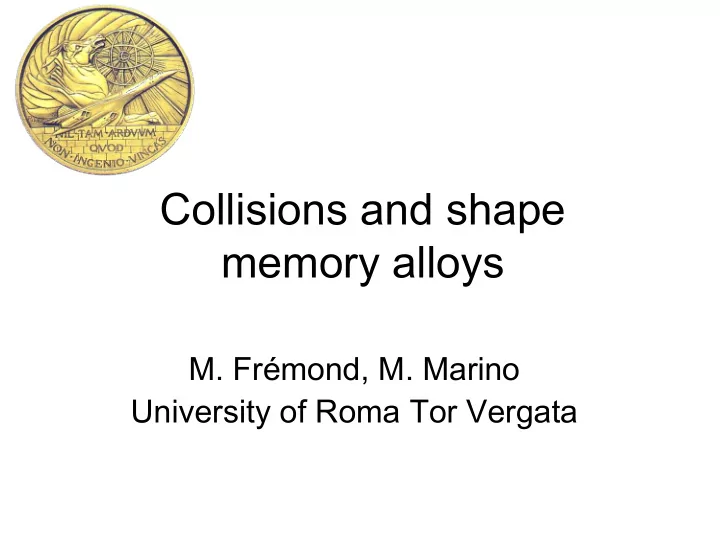

Collisions and shape memory alloys M. Frémond, M. Marino University of Roma Tor Vergata
1 2
± T 1 B ± ± 21 T 2 B 2 ± ± T 1 B 1 2 1 ± T 2 B 21
Tennis table ball: 1 1 2 3 Soccer ball: 2 Floor: 3
Warm rain droplet Frozen ground
Stone or swimmer Γ contact surface Ω Water
Γ Positions of the fractures are unknown obstacle r r − − U U Collision is instantaneous. r r There are velocities before collision and velocities after U − U + ( x ) ( x ) collision r Fractures result from the collision. Thus velocity is + ( x ) U a discontinuous function of x
The velocities are discontinuous: with respect to time r r + − − ( ) ( ) U x U x with respect to space [ ] [ ] r r r r r + + + = − = + + − ( ) ( ) ( ) ( ) ( ) U x U x U x U x U x r l r N Γ right left
There are closed form solutions for 1-D problems: A stone is tied to a chandelier. Work with Elena Bonetti, Pavia University
Work with Francesco Freddi, Parma University
Mathematics with Elisabetta Rocca, Milano University
Applications The results from the collision SMA predictive theory are the input data for the thermomechanical smooth problem describing SMA evolution (Frémond model). � Impact and post ‐ collision behavior of a 1D beam structure: T − <T o , β 1 − = β 2 − =0.5 y G p 0.6 〈 � 〉 =average along the beam u 0.4 0.2 u [m] 0 -0.2 -0.4 SMA -0.6 Linear elastic 0 0.01 0.02 0.03 0.04 t [s] Computational step size is limited only by the smooth evolution problem (structural natural frequency).
SMA constitutive modeling: collisions Impact behavior depends on classical SMAs parameters and on: c c : collision viscosity of phase change; ν c : collision viscosity of phase change diffusion; Simplified assumptions: k v : collision viscosity of velocities. ‐ T − <T o , β 1 − = β 2 − =0.5 ‐ Homogenous case: ∇ T=0, ∇ β = 0 Lower c c , - Dissipated power ζ = σ p : ε ( v ) is known easier is the phase change += β 2 + 1 β 1 + β 3 1.1 += β 2 + β 1 0.8 + β 3 1.05 0.6 c c c c T+/To [-] β [-] 1 0.4 c c 0.95 0.2 0 0.9 0 100 200 300 400 500 0 100 200 300 400 500 ζ [MPa] ζ [MPa]
SMA constitutive modeling: collisions Impact behavior depends on classical SMAs parameters and on: c c : collision viscosity of phase change; ν c : collision viscosity of phase change diffusion; k v : collision viscosity of velocities. T − <T o , β 1 − = β 2 − =0.5 y G p += β 2 + β 1 + β 3 0.8 0.6 Higher ν c ν c β + [-] more uniform is the 0.4 phase change ν c 0.2 0 0 2 4 6 8 10 y [m]
SMA constitutive modeling: collisions Impact behavior depends on classical SMAs parameters and on: c c : collision viscosity of phase change; ν c : collision viscosity of phase change diffusion; k v : collision viscosity of velocities. T − <T o , β 1 − = β 2 − =0.5 y G p Higher k v Smaller the post ‐ collision velocity Lower is the phase change 1 0.8 0.6 + [-] 0.4 β 3 0.2 kv 0 0 2 4 6 8 10 y [m]
Recommend
More recommend